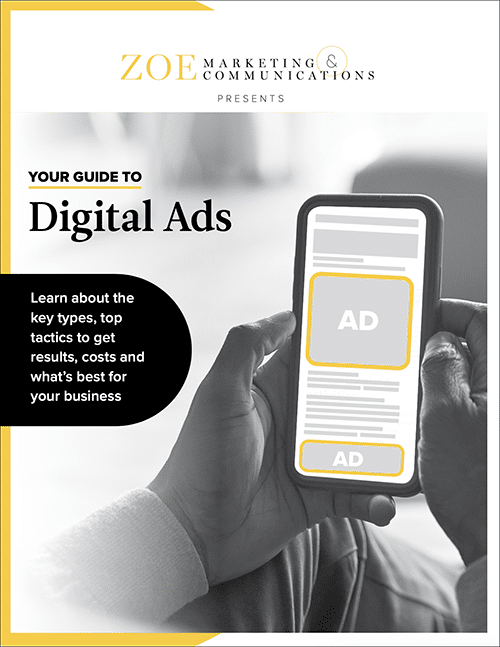
Download Your Digital Ads Guide
Learn how digital ads can help your business, including the tools, techniques and strategies to create successful campaigns.
November 23rd, 2022 | 2 min. read
By Kim Kovelle

“Googling” products and services is big business. Nearly 54% of all product searches start on Google, and the first five results capture 68% of the clicks.
If your business isn’t ranking high on search engine results pages (SERP), you’re missing out. That’s where search engine marketing (SEM) comes in. SEM helps businesses show up in paid search results, putting their brand in front of the right people at the right time.
Zoe Marketing & Communications has helped businesses maximize digital ads since 2020. In this article, we’ll break down how SEM works, the types of ads available, and whether it’s a good fit for your marketing strategy.
Learn how digital ads can help your business, including the tools, techniques and strategies to create successful campaigns.
SEM increases website visibility using paid search ads. These ads appear at the top of Google searches and can also display on other websites, apps and even in email.
Unlike SEO (seach engine optimization), which is organic and takes time to build), SEM delivers faster results through pay-per-click (PPC) advertising.
Businesses bid on keywords, competing for ad placement. If your bid and Quality Score (Google’s measure of ad relevance) are high enough, your ad appears in the search results.
Depending on how you set them up, SEM ads show up in different ways.

These text ads appear at the top of Google results when users search for specific keywords. They closely resemble organic results but have a small “Ad” label.

These visual ads appear on over 35 million websites and apps, reaching targeted audiences as they browse online.

These ads display product images, pricing, reviews and store info, making them ideal for e-commerce businesses.

Since YouTube is owned by Google, text and display ads can appear in search results or alongside videos.

These ads appear as “unread” emails at the top of users’ Promotions inbox.
SEM is a versatile tool for businesses of all types. Some of its biggest advantages include:
Costs vary widely based on industry, keyword competition and geographic location. Some highly competitive industries, like legal or finance, may pay over $50 per click, while others average just a few dollars.
SEM isn’t a “set it and forget it” marketing tool. It requires constant monitoring, adjustments and testing. If you’re considering managing SEM in-house, you’ll need:
Working with an agency saves time and maximizes results. Agencies refine targeting, optimize bids, and track performance to prevent wasted ad spend.
SEM is a powerful way to increase visibility and drive conversions.
If you’re ready to explore SEM for your business, talk to us at Zoe Marketing & Communications. Our digital marketing experts can build a results-driven SEM strategy that aligns with your goals.
Still exploring your options? Check out these resources:

Learn how digital ads can help your business, including the tools, techniques and strategies to create successful campaigns.
As Zoe Marketing & Communications’ content manager, Kim Kovelle brings over 20 years of writing and editing experience in metro Detroit. She has strong roots in community journalism and a knack for making complicated topics make more sense.
